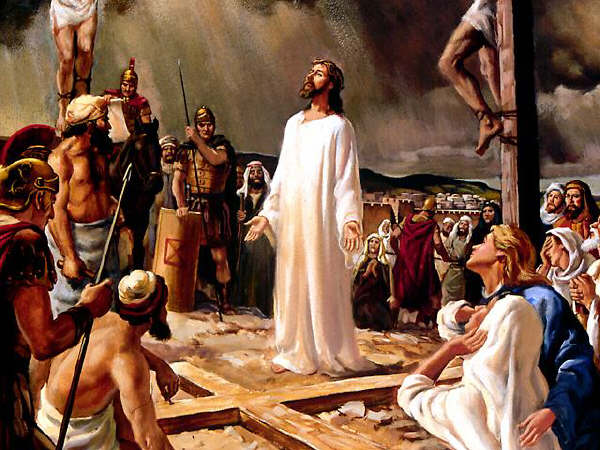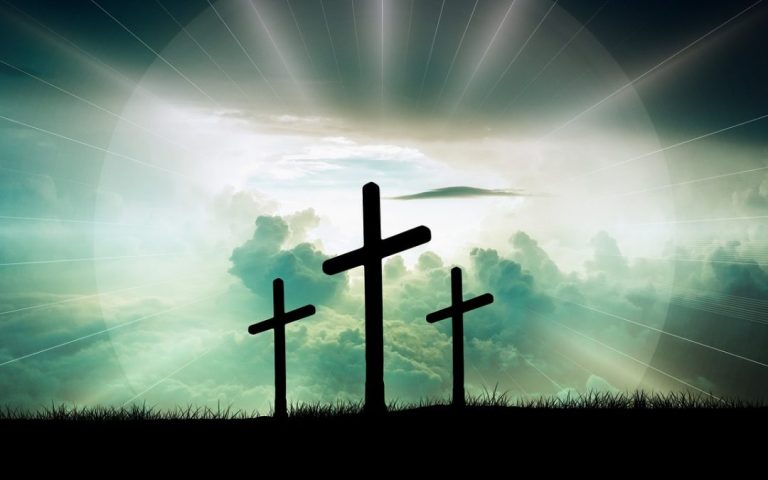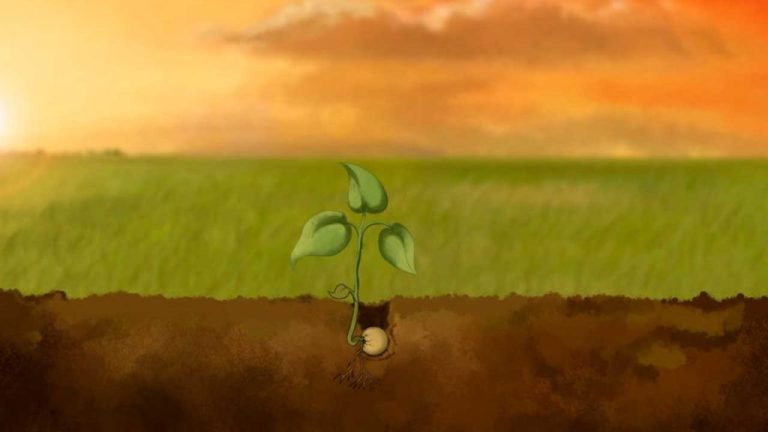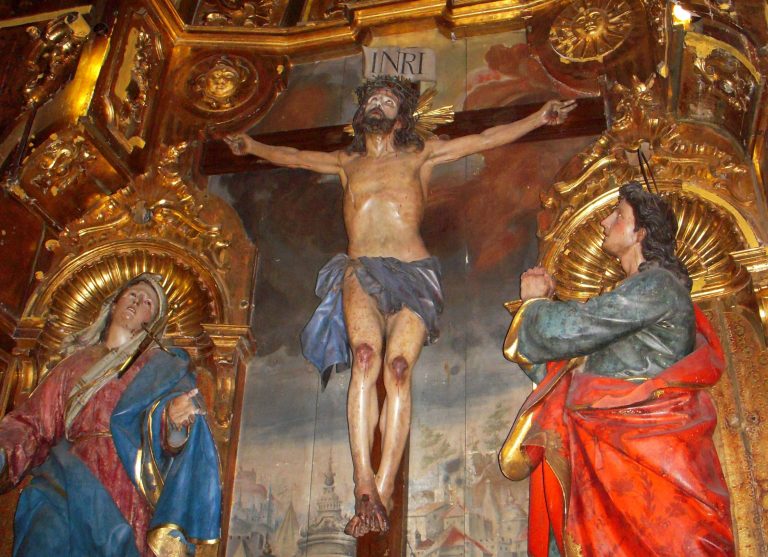Get to know the place where Jesus of Nazareth was crucified, here
Many accounts explain about the crucifixion, but not all of them specify the place where Jesus of Nazareth was crucified. Learn more about this topic in the next post.
Where was Jesus of Nazareth crucified?
The place where Jesus of Nazareth was crucified is known as Calvary, also called the Golgotha site, it was a space that was near the outside of the dividers of Jerusalem. In this place according to accounts, Jesus was killed.
In the Greek content of Matthew, Mark and John, its interpretation is given as a position of the Skull, full of Latin as Calvari Locus, from which the Spanish word Calvario is inferred, in the Gospel of Luke it is basically called, Place of skull.
The historical background depends on the Hebrew root, from which the Hebrew word skull is determined. Some elective clarifications have been given. It has been suggested that the Aramaic name means “mount of execution”, and that its area is equivalent to the Goatha referred to in the section of the book of Jeremiah depicting the geology of Jerusalem. (See Article: The power of Prayer )
An elective clarification is that the place was only for open executions, and that the name referred to the deserted skulls that could be found there, or that it was located almost in a cemetery and that the name referred to the bones.
In some Christian and Jewish customs, Golgotha is where Adam’s skull is located. A common adaptation of this convention says that Shem and Melchizedek ventured to Noah’s Ark, retrieved Adam’s skull, and were guided by blessed messengers to Golgotha. (See Article: The power of early morning prayer )
He is portrayed as a pendant molded from a skull in the most central place in the world, where the leader of the serpent of Eden was also. This custom appears in numerous old-fashioned sources. In addition, it is recommended that the orography of the history of the spot have the status of a skull and, therefore, have that name.
The usual area of Golgotha derives from the distinguishing test of Helena, the mother of Constantine I, in the year 325. A couple of meters Helena distinguished the area of the tomb of Jesus and said that she found the genuine cross. Her son Constantine built the Church of the Holy Sepulcher in that condition. In 333, a creator with the alias Pilgrim of Bordeaux wrote in the work Itinerarium Burdigalense:
To the left is the small slope of Golgotha, where the Lord was killed. A short distance from that point is a vault or sepulcher where his body lay, and where he ascended on the third day. There, at present, by order of the Emperor Constantine, a basilica has been built; that is, a congregation of amazing magnificence.
The plans distributed in the book show that Golgotha has a room for errors of less than two meters, below the central section one meter from where the grisly garments of Jesus were said to have been recovered and just before the stairs that lead to the sanctuary of St. Helena, which is otherwise called the house of prayer of St. Vartan.
Area in connection with city dividers
The New Testament describes the site of the torturous murder, Golgotha, as the area “near the city” and yet “outside the city dividers.”
The conventional area is in the central point of the city of Hadrian, as well as within the border of the ancient dividers of Jerusalem; in this way, there is some vulnerability about the authenticity of the usual proof of that land.
Some safeguards of this convention have reacted that the border of the dividers was much smaller in the time of Jesus and that Calvary was outside those dividers; however, it is noted that Herod Agrippa extended the city divider to the north, and it is further accepted that the dividers extended to the west.
In 2004, Professor Sir Henry, a senior member of the Christian Church in Oxford, claimed that when Hadrian’s buildings staked out the old city, they “accidentally anchored Golgotha within the new dividers.”
Some Protestants place it elsewhere as a divider would suggest the presence of a sheltered canal outside of it, so the crude divider could not have been near Calvary, and furthermore the proximity of the Temple Mount would have left little room within it. the dividers for the rest of the city, particularly in case you think Calvary would be outside of these.
Essentially, had the conventional site been behind the divider, the city would have been confined to the lower part of the Tyropoeon Valley, rather than including the protective leeway of Western Hill. As these geological surveys suggest that excluding Western Hill within the dividers would make the city more and more inclined to assault, it was considered for each description of Calvary.
elective areas
The usual Calvary area has not been fully recognized by everyone. In 1842, a Dresden scholar and biblical researcher named Otto Thenius depended on the exploration of Edward Robinson to distribute a theory showing that the rugged ridge outside Damascus Gate was the biblical Golgotha.
It was in later years that Major General Charles embraced this hypothesis, which is why this place has also been called Gordon’s Calvary.
The area, currently called Skull Hill, has a cliff at the base with two huge openings, which Gordon felt were taken through the eyes of a skull. He, and others before him, have thought that this is the motivation behind why it was known as Golgotha, implying the meaning for a skull.
Near Gordon’s Calvary is an ancient rock-cut tomb known today as the Garden Tomb. Gordon suggested that this was the tomb of Jesus. The Garden Tomb contains some internment premises.
The excavator Gabriel Barkay accepts that the tomb dates to at least the 7th century BC. what is more, it was deserted in the main century. Eusebius of Caesarea said that Golgotha was now at the ideal time “north of Mount Zion.” (See Article: Prayer to sleep well without nightmares )
Although the term Mount Zion had recently been used to refer to the Temple Mount, the leading Jewish student of history of the last century, Flavius Josephus, who knew Jerusalem before the annihilation of the Romans in AD 70, said that Mount Zion was seen like the Western Hill, which sees it to the south of the Garden Tomb and the Church of the Holy Sepulchre.
Rodger Dusatko, an evangelist from Germany, proposed another area. He accepts that this great place, Golgotha, is before the Lion’s Gate. The accounts of the disciples Matthew, Mark, and Luke take the position when Jesus dies and discovers that the sanctuary cloak was torn.
For their part, the main Aramaic accounts, the Diatessaron of Tatian and the Fathers of the Church affirm that the cover of the sanctuary passage was divided, however, not the layer that was inside the well-known Holy of Holies.
Because the sanctuary was built to the east, the window covering or trim was visible to people on that slope, which is located in the upper east corner of the Temple Mount, just outside the city divider.
Also, to claim that the shadow was broken at the moment Jesus passed away, they would have to have been direct observers of the scene. The Gospel of John alludes to Golgotha as being exceptionally close to the city, so that all who pass by can peruse the engraving on the cross of the censored.
In the event that the prediction of Psalm 69:12 is to be considered, the place of execution could have been so close to a city gate that Jesus could have heard people arguing about it. Also, Eusebius comments on Golgotha in his Onomasticon that Golgotha was simply coming out of Jerusalem, north of ancient Mount Zion, so the slope fits this depiction.
the crucifixion
The crucifixion is the great murder of Jesus that occurred in Judea between 30 and 33 AD. The torturous murder of Jesus is described in the stories and referred to in the epistles of Scripture.
Most history students and New Testament practitioners perceive the death on the cross of Jesus of Nazareth to be a verifiable reality, confirmed by antiquarians and other non-Christian creators of the first and second period hundreds of years ago. Be that as it may, there is no agreement among antiquarians about the conditions or subtleties of this event.
As the New Testament indicates, Jesus was captured, suffered by the Jerusalem Sanhedrin and condemned by the procurator Pontius Pilate to be flogged and inevitably executed. Collectively, these occasions are known as “the enthusiasm of Christ.”
Some non-Christian sources, for example Josephus or Tacitus, also give a chronic, albeit exceptionally sketchy, picture of Jesus’ unpleasant death. On the other hand, for most Biblicists, the closeness of an engraving or trial title of Jesus of Nazareth, collectively present in all four accepted accounts, is perhaps the strongest datum of the engraved character of his energy.
The persistence of Jesus and his demise speak to the core parts of Christian religious philosophy, including the rules of salvation and amendment.
Christians have philosophically understood the death of Jesus on the cross as death by giving sacrifice of penance. Catholic and Orthodox Christians praise the Eucharist as an actualization or continuation, paying little respect to reality, of this equivalent penance.
The “enthusiasm of Christ” means “sufferings that Jesus Christ witnessed before passing the cross”, with no vital connection to a specific, authoritative or fanciful gospel, however, some have tried to make a friend of the four sanctioned accounts.
For example, Tatian from now on in the later century and among the current scholastics. This history was never recognized as homogeneous, as confirmed, for example, by Christians and Latins on the date of the Passion of Christ. Furthermore, the Syrian Church, which received the Diatessaron from Tatian, who led the four authorized accounts, later wanted to abandon it for the symbols of the gospel.
preliminary and conviction
The trial and disappearance of Jesus Christ are described explicitly since some creators consider it conflicting, in light of the fact that the subtleties referred to do not correspond to each other, in addition to the reverse events.
As the three short gospels of Matthew, Mark, and Luke indicate, Jesus was captured in the Gethsemane nursery by a forced gathering of devout clerics, copyists, and the elderly; he was honored by Judas Iscariot with a kiss.
As indicated by John, the individuals who captured Jesus were vigilantes delegated by the esteemed ministers and the Pharisees, together with a unit of soldiers under the command of a “chiliarch”, a Greek word that the Greeks often use to refer to a Roman military tribune, which appears to present the capture as designed by a Roman officer with combatants from the praetorium. In this variant, Jesus recognized himself.
Jesus before Caiaphas
After his capture, Jesus was taken, as the accounts indicate, to the place of the esteemed clergyman Caiaphas. As the Gospel of John indicates, he was first brought before Annas, who then sent him to Caiphas, the respected and esteemed cleric of that year.
Jewish custom records the cruelty of the Sadducean ruling class: woe to me for their criticism! Unrecognizable that God is as he says. -She expressed. (See Article: Prayer to succeed at work )
seasons or falls
Sentenced to carry the patibulum or giant and heavy cross, to the tortuous murder site. As the brief accounts indicate, simply being led out to be executed, he was forced to leave the cross to a man named Simon of Cyrene.
There is never any reference in the stories to Jesus falling to the ground under the weight of the cross or to a lady named Veronica wiping her face with a tablecloth: those stories go back to a later religious convention. Interestingly, the Gospel of John makes no reference to Simon of Cyrene, but depicts Jesus carrying his own cross.
In the accounts, Jesus was directed to a place called Golgotha, which means, in Aramaic, “place of the skull.” The Gospel of Mark says that Jesus was executed at the third hour, that is, towards the beginning of the day, while the Gospel of John says that it was at the sixth hour, that is, the 11th in the first part of the day at 12 pm).
The synoptics state that he was executed between two plunderers, or transgressors, one on his left side and one on his right side. John’s record only says that he was executed between two individuals, without indicating his wrongdoing.
Exploitation and disappearance
It was usual for execution meetings to be held with four officers and a centurion, and that they could guarantee the benefits of the injured individual as an important aspect of their salary. Of course, the Bible portrays that, after killing him, the warriors separated his garments.
Furthermore, contrary to what is generally talked about in Christian crafts, Professor Josef Zias, an anthropologist at Rockefeller University and former curator of the Israel Department of Antiquities and Museums, recommends that the torturous killings in Judea would not have been the subject of great crosses.
This follows that, given that the most accessible wood for executions would be olive trees and these trees are not exceptionally tall, it was proposed that people be killed “at eye level with witnesses.”
As the Gospels indicate, the Romans nervously gave Jesus wine. In the season of Jesus Christ, the Roman soldiers drank a languid, acid or severe wine, called in Latin acetum which is equal to vinegar or, when added with water, is called “posca”.
This was probably the drink that was offered to Jesus while on the cross. According to some accounts, he denied that a hard wine mixed and sedated with myrrh was presented to him to reduce his distress.
Around three in the afternoon, Jesus shouted: “Eloi, Eloi, lamá sabactani”, which in Aramaic means: “My God, my God, why have you rejected me?” His final words before finishing were: “Father, in your hands I endowed my soul.” Or basically “Everything has been satisfied”, so the last expressions of Jesus also vary in the stories.
nailed hands
The Gospel of John says that Jesus had his hands nailed. In any case, the Greek word for hand, used in the gospel, is kheír, which refers to both the forearm and the hand.
This word used in the accounts interpreted as “hand” also appears in the Acts of the Apostles, where Peter’s chains are portrayed as falling from “his hands”, as they are more likely to have been placed on his wrists.
In this regard, Dr. Frederick Zugibe, former Chief Restorative Analyst of Rockland County, New York, accepts that the nails could have been placed entering the palm, at the base of the thumb, and out of the wrist, through the passage of the thumb. carpal bone
As to whether Jesus’ feet could be fixed on the cross, the remaining parts found in 1968 in the city of “Giv’at ha-Mivtar” north of Jerusalem, offer the main cement anthropological track found in an execution.
Archaeologist V. Tzaferis examined the remaining parts and found that there was still a corroded nail on the calcaneal bone of the correct foot on the expired foot. He was a young man who had been executed somewhere in the range of 7 and 66 AD.
Professor Nicu Haas, an anthropologist at the Hebrew University and Hadasha College of Medicine, Jerusalem, conducted an examination of the Site where Jesus of Nazareth was crucified and analyzed the remaining parts. Haas surmised that the two heels had been driven in by a nail of at least 12cm.
A resulting survey of the site where Jesus of Nazareth was crucified, conducted in 1985 by Professor Joe Zias and Dr. Eliezer Seketes, of the Hebrew University and Hadasha School of Medicine, showed that the nail Haas had assumed from 17 to 18 cm long, it was really only 11.5 cm, with which each foot was nailed independently to each side of the cross.
Additionally, some acacia wood was found between the bone and the nail head, probably used to prevent heels from slipping through the nail. -These are specific data of the place where Jesus of Nazareth was crucified.
That route might well have happened with Jesus. However, The International Standard comments: There has been a significant hypothesis about the ultimate measurement of nails used that cannot be overlooked, even its details are precise and reliable.
In the most experienced representations where Jesus of Nazareth was crucified, that is, the outstanding crucifixion of Jesus, what happened in each part of his body, Jesus’ feet appear nailed independently, however, in later representations they are crossed and Are fixed.
Possible reasons of death
A few analysts have accepted that the disappearance of Jesus could have happened due to a “broken heart” due to the disclosure story of water and blood shed from Christ’s wound while magnifying the anguish and despair in his body. .
According to them, the cardiovascular explosion would have been identified with past myocardial damage that could have occurred due to a blow to the chest or contusion to the chest during the performance. The story about blood and water could basically be a representative or “phenomenal” story with no measurable critique by clinicians.
A hypothesis by Pierre Barbet about the place where Jesus of Nazareth was crucified expresses that the reason for his sudden death on the cross was suffocation. After all, since the outstretched arms support the entire heaviness of the body, the condemned man had serious problems breathing, due to the hyperexpansion of the intercostal muscles and the chest.
Therefore, the murderers used to break their legs with iron hammers in case they needed to quicken their pace, since the unfortunate victim was left without help to get up and continue to relax, this also happened at the place where Jesus of Nazareth was crucified with the wrongdoers.
According to Dr. F. Zugibe
Be that as it may, Dr. F. Zugibe, from Columbia University, with a study on the place where Jesus of Nazareth was crucified, explained, as a result of directing some tests to volunteers since 1980, that when someone is suspended with the arms 60° to 70° from vertical, despite the fact that he is challenged in breathing, this does not produce sudden death.
Keep in mind that the previous tests, where collapse occurred in just six minutes, were done on people suspended by the wrists less than 40 inches, that is, we mean one meter away from each other.
Notice also that Jesus was suspended for a couple of hours, not like some writings about the place where Jesus of Nazareth was crucified that say ten minutes. Zugibe says that the crurifragium was clearly used as a “knockout blow,” causing horrifically severe dazes or a stroke, yet it did not cause the least bit of asphyxiation.
Today it is accepted that going through a cross could occur for different reasons, for example, hypovolemic stunning due to drainage caused by whipping and nails; summed up sepsis thanks to multiple contaminated lesions. It could also occur by joining a progression of different causes, for example, dryness, sunstroke, constant tiredness, which in the end could lead to heart failure and different complications.
For each of these reasons, it is not reasonable to declare that Jesus’ disappearance was for a solitary reason. In any case, there are people who defend the theory that Jesus couldn’t speak if he wanted to on the cross, but would have essentially forgotten that he even existed over time.
In short, there are infinite theories about the place where Jesus of Nazareth was crucified, until today according to the margin of the scriptures it is emphasized that the death of Christ has a more spiritual than physical cause, and much more of divine than secular origin. . (See Article: Prayer to start the school year )

Hello! Let me enthusiastically introduce myself as a dedicated blogger fueled by an intense passion for meticulously crafting insightful and well-researched blogs. My mission revolves around providing you, dear readers, with a veritable treasure trove of invaluable information.







